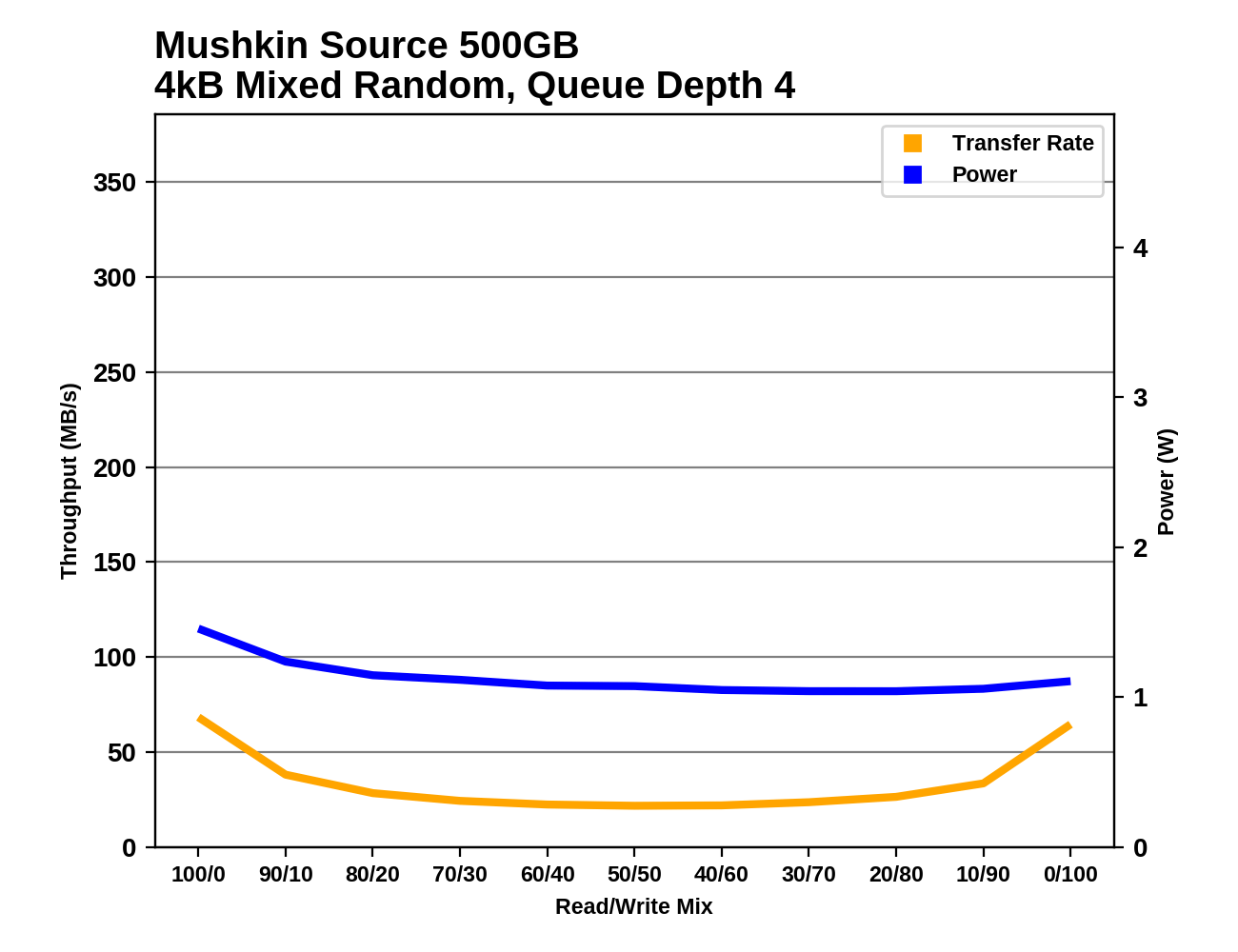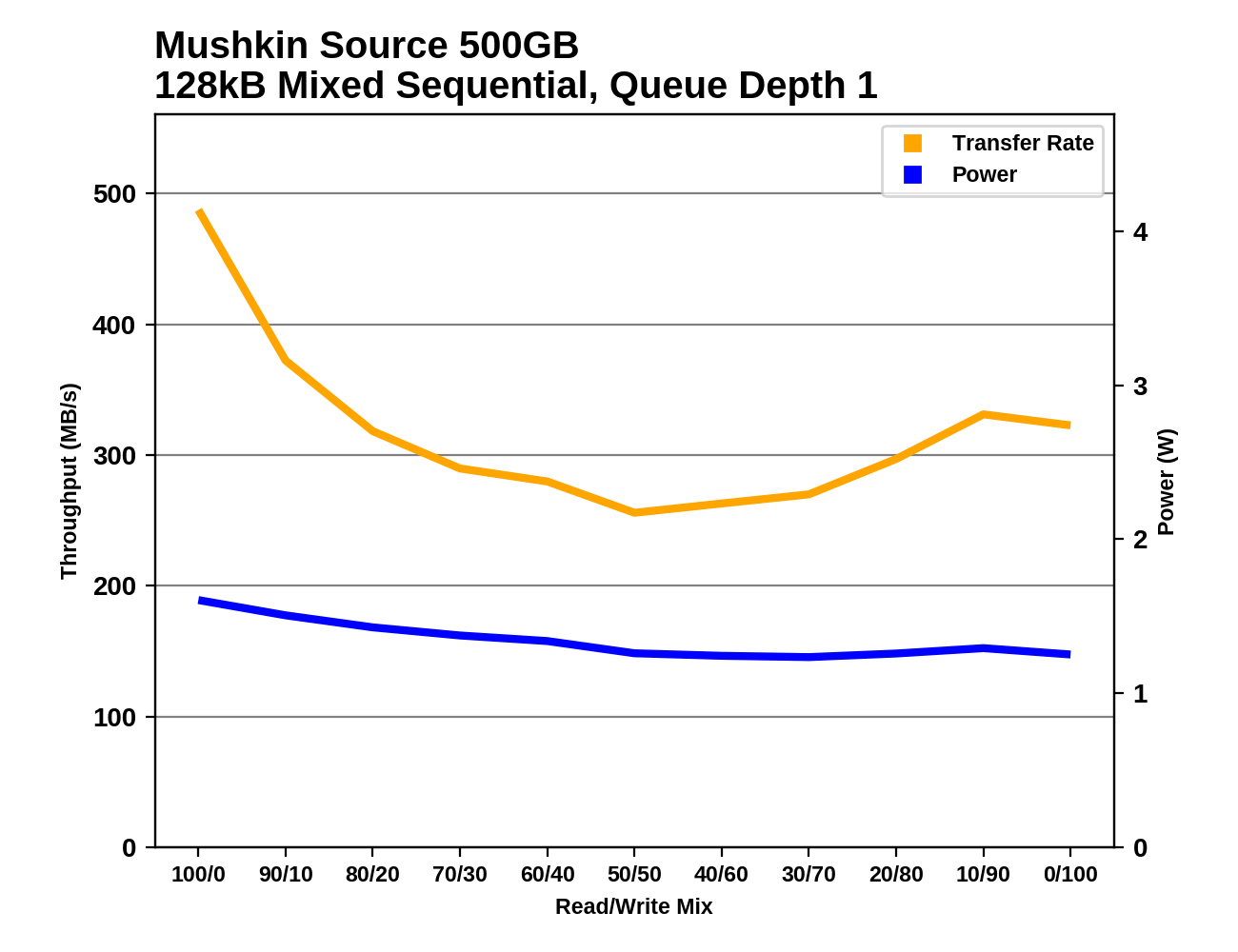The Mushkin Source 500GB SATA SSD Review: A Value Proposition For An Everyday PC
by Billy Tallis on November 21, 2018 10:00 AM ESTMixed Random Performance
Our test of mixed random reads and writes covers mixes varying from pure reads to pure writes at 10% increments. Each mix is tested for up to 1 minute or 32GB of data transferred. The test is conducted with a queue depth of 4, and is limited to a 64GB span of the drive. In between each mix, the drive is given idle time of up to one minute so that the overall duty cycle is 50%.

The Mushkin Source does not handle the mixed random I/O test well at all, with performance that is barely faster than the HP S700 and much slower than the Toshiba TR200, let alone the mainstream SATA SSDs that have a DRAM cache.
 |
|||||||||
| Power Efficiency in MB/s/W | Average Power in W | ||||||||
The Mushkin Source uses a bit more power than the HP S700 on this test, so it ends up falling to last place on the power efficiency ranking. The Toshiba TR200 uses less power than the other two DRAMless drives and substantially outperforms them, so its efficiency is close to competitive against the mainstream drives.
 |
|||||||||
The Mushkin Source displays a typical bathtub curve for performance on the mixed random I/O test. With pure reads or pure writes, it is substantially faster than with any mix, and the lowest performance is with around a 50/50 mix of reads and writes. Most mainstream SATA SSDs these days show significant performance growth throughout the test as the workload becomes more write-heavy, finishing with a significant spike in performance at the end when the SLC cache can be used to the greatest extent possible.
Mixed Sequential Performance
Our test of mixed sequential reads and writes differs from the mixed random I/O test by performing 128kB sequential accesses rather than 4kB accesses at random locations, and the sequential test is conducted at queue depth 1. The range of mixes tested is the same, and the timing and limits on data transfers are also the same as above.

The Mushkin Source comes close to the performance of mainstream SATA SSDs on the mixed sequential I/O test, but it is still handicapped slightly by the DRAMless controller despite having turned in competitive scores in the tests of pure sequential reads and writes.
 |
|||||||||
| Power Efficiency in MB/s/W | Average Power in W | ||||||||
Unsurprisingly, the Mushkin Source continues its trend of very good power efficiency during sequential I/O, ranking just below the HP S700 and above all the mainstream SATA SSDs.
 |
|||||||||
The Mushkin Source's behavior on the mixed sequential I/O test is quite similar to the HP S700: a steep decline in performance during the first half of the test as the workload shifts from pure reads to a 50/50 mix, followed by a moderate performance recovery. The mainstream SATA SSDs that show higher overall performance win out during the middle phases of the test, where they lose less performance as writes are introduced.










30 Comments
View All Comments
Adramtech - Thursday, November 22, 2018 - link
what are you referring to? This uses Micron and it's TLCgglaw - Saturday, November 24, 2018 - link
lol yea, are people not even reading these articles? It is using one of the best selling controllers with a great track record for a low cost one, with Micron's 64L 3D-NAND which also speaks for itself. There is nothing "risky" with this drive. Every aspect of it is very well known.Lolimaster - Thursday, November 22, 2018 - link
Till now you can still get the Samsung 860 EVO for $130.Darcey R. Epperly - Friday, November 23, 2018 - link
Good drive to speed up my Gaming Console. I don't need a high write performance.Samus - Friday, November 23, 2018 - link
Always nice to see competition, but still hard to consider this over an MX500 that sells for virtually the same price.nwarawa - Friday, November 23, 2018 - link
70MB/s seq write?! REALLY?! Makes it garbage as an upgrade. This SSD would be the bottleneck transferring from a HDD... smh.Billy Tallis - Friday, November 23, 2018 - link
Yes, but how often do you really transfer more than 150GB at a time? Even putting a full OS+apps image onto the drive probably wouldn't do that much writing in one shot. If you're only writing tens of GB at a time, this drive is still twice as fast as a hard drive.nwarawa - Friday, November 23, 2018 - link
Personally? Often. I move video folders between drives often as the projects go to cold storage. Laughable that this would be slower than my 4tb HDD at this task. But I upgrade people from HDD storage, or even smaller SSD, ALL THE TIME. MX500 or 860 EVO will image an existing 250GB so much faster.gglaw - Saturday, November 24, 2018 - link
To be fair that's a TINY niche scenario no budget drive is trying to fill. Having a performance drop after >150GB of data is transferred is something most users will encounter a couple times a year at most. Even if they are doing a full drive migration, as Billy pointed it, for most users it won't past the threshold and this is the one and only time a typical user MIGHT encounter the problem. If it adds 5 minutes to the clone time for the handful of GB after 150GB is cloned, that's the least of most users problems.The current prices make no sense either way though. It is way too close to the MX500, but the prices will have to settle into sensible patterns or these will just rot away in warehouses. I imagine the actual sell prices will end up significantly lower than MSRP. For any of my spare home rigs or office computers, the limitations of performance drop after 150GB would not bother me one bit as long as it saved enough cost to justify it. I would gladly take even a steep dropoff at 50GB if it saved several more bucks. The times I would be transferring more than this I would either A) be using my main computer or B) not sitting there waiting on the transfer/clone. I build or upgrade enough systems that anytime a workload even passes the 5 min mark, there's something else I could be working on (or sneaking in another OW match).
dromoxen - Sunday, December 9, 2018 - link
the price paid in the retail market , specifically Western Markets, is not indicative of the price OEM's pay or say LA/Far Eatern markets .I am noticing a bias against Chinese Brands simply based on their Chinesity?, is this how we stop them taking over the PC components world? HUAWEI e.g.